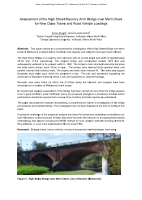Bridges

- Publication no: ABC2017-016-17
- Published: 20 April 2017
- PDF (free) Download
This paper reports on a comprehensive investigation of the High Street Bridge over Merri Creek in Melbourne to determine its condition, load capacity and rating for trams and road vehicles.
The High Street Bridge is a masonry arch structure with an overall length and width of approximately 45.0m and 17.3m respectively. The original bridge was constructed around 1875 and was subsequently widened to its present width in 1890. The bridge’s main structural elements comprise two brick barrel arches, each 18.5m in span. The arches carry external brick spandrel walls, and parallel internal brick buttress walls. The arches and walls retain internal fill. The walls also support bluestone deck slabs upon which the pavement is laid. The pier and abutments supporting the arches are of bluestone masonry; these in turn are supported on concrete footings.
Recently, new class trams (of which the E1-Class being the heaviest and longest) have been introduced on a number of Melbourne’s tram routes.
No recent load capacity assessment of the bridge had been carried out and while the bridge appears to be in good condition, under VicRoads’ policy any proposed changes to a structure’s function and/or performance standards requires that a review of its condition and load capacity be undertaken.
The paper discusses the reasons necessitating a comprehensive (Level 3) investigation of the bridge and presents some initial findings. The investigation has not been finalised at the time of writing of this paper.
A particular challenge of the structural analysis has been the limited and sometimes contradictory as- built information on the structure. Another key issue has been the selection of an appropriate analysis methodology with options including the MEXE method to more complex methods including Archie-M, Ring software, or even more sophisticated 3D non-linear FEM.
